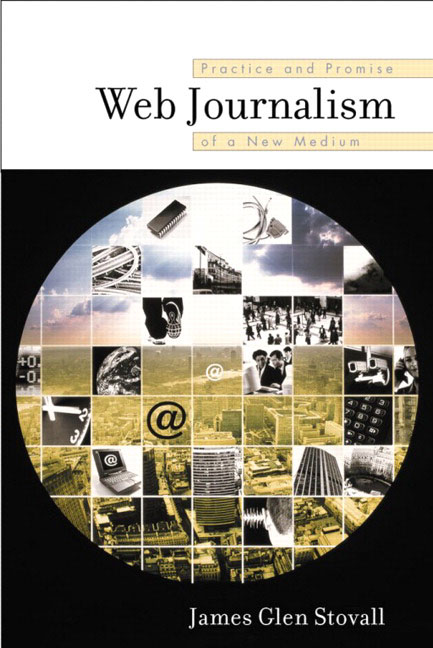
Web Journalism
Practice and Promise of a New Medium
James Stovall
Feb 2004, Paperback, 256 pages
ISBN13: 9780205353989
ISBN10: 0205353983
Description
Journalism on the Web explores the current practices and future possibilities of Web journalism and examines the characteristics of the Web that distinguish it from traditional media.
top
Contents
Preface
1. Logging on to the Web.
What Is the World Wide Web?Disadvantages of the Web.Whither Web Journalism?SIDEBAR: September 11, 2001.SIDEBAR: The President and the Intern.SIDEBAR: The Starr Report.COOL IDEAS: Don't Read and Drive; Listen Instead.
2. News Web Sites.
Defined and Current.Owned and Operated.Developing a Web Site (Or Not).Growing the Web Site.Independently Owned.News Sites that Didn't Mean to Be.Web Logs: A New Form of Journalism?Whither Web Sites?SIDEBAR: Content Management Systems.
3. News: Expanding the Definition.
Old News, Good News.News, and More of it.No More Deadlines.Non-Linearity.Audience-Generated News.Personalized News.Web Logs as News.Unseparating Church and State.And Finally…COOL IDEAS: If Readers Could Choose.
4. Reporting: Gathering News for the Web.
Something Old, Something News.Reporting: Where Journalism Begins.What Makes a Good Reporter.Sources and Procedures.Stored Sources.Speed and No Deadlines.Versatility and Teamwork.Beyond Traditional Sources.Lateral Thinking: Mind Expansion for the Web Journalist.Layering Information.What It Takes.
5. Writing.
Writing for the Media.Techniques of Journalistic Writing.Structures from Print.Web Writing Structures.Summaries.Writing for Visual Effect.New Forms of Writing.Web Logs.It's Still About Journalism.
6. Editing.
Editing for the Web.Upholding Standards.First Duty: Know the Language.Second-Level Editing: Formulating the Language.Headline, Summaries and Links.The Editor-Reporter Relationship.Convergence: Where Media Meet.Site Design and Organization.Encouraging and Managing Interactivity.Preserving the Site.SIDEBAR: Journalistic Style.SIDEBAR: The Five Commandments for the Copyeditor.
7. Photojournalism
Photojournalism: Journalism, Only Different.Life and Times of the Photojournalist.Developing the Good Picture.The Photo in Print.The Digital Revolution.The Web: Medium of Acceptance and Change.Ethical Considerations.Photo Web Sites.The Promise of the Web.
8. Graphics Journalism: Words and Pictures Together.
Graphics Revolution.Informational Graphics.Type-Based Graphics.Chart-Based Graphics.Three Basic Charts.Maps.Developing Infographics.Graphics on the Web.The Immediacy of Graphics Journalism.Animation.Conclusion.COOL IDEAS: Floating in Words.
9. Audio and Video: Sound and Little Fury.
The Web and Broadcast News.Reporting and Writing for Broadcast.Story Structure.Broadcasting Formats.Broadcast News Web Sites.Webcasting and Video on Demand.SIDEBAR: Broadcast Style.SIDEBAR: On-the-Air to Online.
10. Design: What Goes Where.
Sept. 11 and Beyond.Design and Layout.Visual Logic.Design Concepts.Three Elements of Design.Web Site Design.Organizing a Web Site.Web Pages.The Front Page.Section Fronts.Article Pages.Special Sections.Conclusions.
11. Engaging Audiences.
The Death of All Media.A Growing Audience.The Interactive Audience.Audience-Oriented Forms.Personalization: The Daily Me.Paying for It.Tracking Audiences.
12. Media Law Online (by Amelia Parker).
Broadcast Regulation.Decency Online.Defamation.Privacy.Copyright.Obscenity and Indecency.Conclusion.
13. The Web Culture: Inside MSNBC.
14. Big Issues.
Galloping Technology.The Digital Divide.Profitability.Will Newspapers Survive?The End of Journalism as We Know It.
Appendices.
Appendix A: Newsgathering Techniques.Appendix B: Journalistic Style.Appendix C: Type and Typefaces.
![Reblog this post [with Zemanta]](http://img.zemanta.com/reblog_e.png?x-id=e4c57400-c670-4cd3-9b2f-865d349f5fa3)

![Reblog this post [with Zemanta]](http://img.zemanta.com/reblog_e.png?x-id=af991d29-564d-42c3-8ffb-74c08a2e0fd0)

![Reblog this post [with Zemanta]](http://img.zemanta.com/reblog_e.png?x-id=9c83714d-5547-470e-92d9-cb354ac1c6bd)